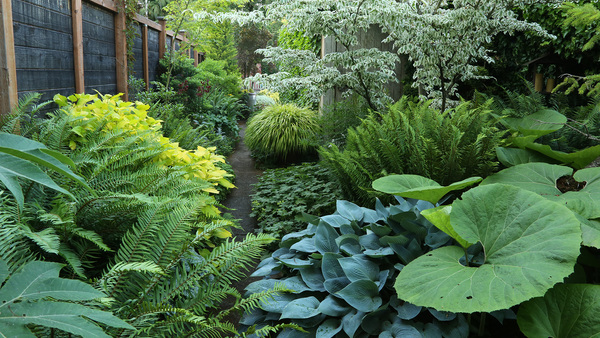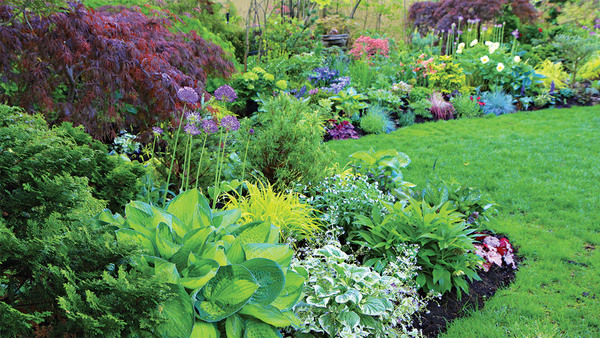
I was painfully shy as a child, often taking refuge in the forested greenbelt adjacent to our suburban backyard. It was the early 1970s, before children were kept on a short tether, and I was allowed to wander so long as I was home before dark. I would explore paths and climb trees, collecting nature and memories as I went. The forest of my youth was mostly conifers, where an occasional mother tree would establish her dominance, reaching out with a great protective canopy underneath which little could grow. I would adopt the ground beneath and “park it out.” This meant removing debris and creating a garden of collected flowers and plants (sometimes with roots still intact), along with laying small circles of stones. I would sit in the mossy solitude on the forest floor with my back against the trunk, feeling safe in the dappled light. It was an idyllic refuge of my own creation, all done on a five-year-old’s salary.
I grew up to become a painter, a sculptor, and a curator. And with adulthood came the realization that a garden could be a work of art as well as a refuge—a stage where I could create a picture, a mood, and a story. Over the course of 20 years I’ve transformed my small urban lot into a living art installation. It is filled with an array of textures and forms, with visual jewels around every corner and the peaceful serenity that makes it a true oasis. (Doesn’t everyone want that from their garden?) And it has all taken shape under the canopy of a mother tree reminiscent of my youth.
Discover 9 Foliage Plants You Can’t Live Without
Create a backdrop of green to foster complete immersion
The property I purchased two decades ago to create my living art installation is a strange cutout from the city around it: a narrow, L-shaped strip of land holding its breath between three normal-shaped lots. When I first found it, all that was there was a hobbled-together house (once a garage) under the canopy of a massive century-old cherry tree (Prunus cv., Zones 3–8). There was no garden, only hardscrabble earth between patches of beastly bamboo and blackberry. One can renovate a house and create a garden, but the magnificent scale of that tree took generations to realize. So I bought the tree.

To filter out the surrounding world, to create privacy, and to provide a solid canvas upon which other plants could shine, a solid green backdrop was installed along many of the property lines. But due to the size of the massive tree’s canopy, the plants beneath needed to be shade loving and willing to put up with lots of root competition. Several years ago I planted a hedge of Leyland cypress (× Cuprocyparis leylandii, Zones 6–10) to provide privacy between my residence and the neighbor’s house to the north (photo above). It runs along from the trunk of the cherry tree to the western property line, turning the corner until it meets the end of my detached garage. Now about 10 feet high, it makes a wonderful green foil for an array of architectural containers and textured foliage as well as creating a comforting garden room. ‘Teddy Bear’ rhododendron (Rhododendron ‘Teddy Bear’, Zones 6b–8) is a broadleaf evergreen that offers a velvety backdrop elsewhere, while a grove of limbed-up lilacs (Syringa cv., Zones 3–7) with zigzag trunks contributes a mundane yet protective canopy in another area. These deliberate measures give the garden a protective womb quality that allows me and others to be mentally present within the garden.

Tip: Use dry shade to your advantage
Several thuggish plants tend to behave better when starved for nutrients and resources like light and water. For example, butterbur can run rampant if given its preferred moist, rich soil. In my garden, however, it stays a fraction of its mature size and politely remains in check. I have chosen many robust plants, some of which would be absolute thugs in more favorable conditions but are subdued here due to the extreme root competition.
Forget the flowers—they’re not the point
My garden isn’t about blooms; it’s foliage-first. Therefore, I choose plants that exhibit bold textures, colors, and shapes. Relying on those traits, I position the plants in a variety of ways to create rhythms throughout the space, or to create complements and contrasts—much as you would with an artwork that aims to produce a certain mood. For example, I adore the color of ‘Wolf Eyes’ kousa dogwood (Cornus kousa ‘Wolf Eyes’, Zones 5–8). Its sharply variegated leaves allow it to be a focal point, especially when it is surrounded by plants with foliage of a contrasting color. You’ll also find drifts of Japanese forest grass (Hakonechloa macra and cvs., Zones 5–9) along the pathways of the garden, and the texture it provides is exceptional. The repetition of this fine-bladed plant provides rhythm and movement to the art of the garden. For form, it’s hard to beat the imposing structure of butterbur (Petasites japonicus, Zones 5–9). Most of the plants I rely on sparkle regardless of the season.


My garden is not completely devoid of flowers, however. I do have some seasonal stars that help to complement the surrounding foliage at specific times of the year, adding interest to an area that might otherwise be lacking. With its curled wax-paper-like party blossoms, ‘Jelena’ witch hazel (Hamamelis × intermedia ‘Jelena’, Zones 5–8) is the first in my garden to herald in the new year. Fothergilla (Fothergilla gardenii, Zones 5–8) has delicate, airy blossoms that seem to float independently of the bush itself in spring. Martagon lilies (Lilium martagon, Zones 3–8) also dot the canvas at the peak of the season, their hues peeking out against the foliage mosaic beyond.
Root competition from the giant cherry is a significant challenge, but I have adapted several strategies for dealing with it: I choose perennials that thrive in dry shade, use containers to maximize planting space in areas with heavily root-bound soil, and allow native mosses to take over in some spots. I’m a fastidious gardener. I preen and clean. Even the bare earth is swept clean. In a shade garden that’s regularly watered and rarely top-dressed, this encourages moss. Here in the Pacific Northwest the mid-green hue of common garden moss creates a web of wool easily rolled back or picked apart by birds and squirrels looking for insects, worms, or a fight (photo below). For years I’ve maintained this carpet because its color and texture add undeniable interest across the lowest layers of the garden canvas.

Paths and patios encourage lingering and an intimate garden experience
Within this tiny landscape are a small courtyard, a brick patio, two concrete pathways, and even a series of granite pavers laid atop the cherry tree roots to create an additional entertaining space. All of these hardscape elements play different roles in the garden: some are located in areas that are extensions from the house to the garden—such as an existing concrete pad that I turned into a patio (photo below). The sidewalk pathways and other hardscape elements are used to draw people deeper into the landscape—all while giving the illusion that they are journeying through a much larger space.


All of the hardscape in this garden is laid out true to the horizon. When you stand with your back to the house, the main path (and surrounding garden) unfolds in front of you, until it disappears at a vanishing point in the distance. The same effect takes place when you stand at the front of the property and take in the view down the alley between the house and garage to the patio beyond (photo right). This orientation forms a foundation. A horizon line lets viewers know where they are in relation to the scene and adds to the dynamic, immersive character of this space.
Over the years, I have transformed the pocket of land beneath the cherry tree into a garden that I love; it’s a place of safety and retreat. Nothing is ever static in this space, and that makes it genuinely transformative for all who step inside it. It is constantly evolving, like a living sculpture. Creating this space was a challenge, but I am a gardener and artist, so of course I like a good puzzle.
Art as inspiration
What I love about a garden is that it is constantly changing. I am always pruning down and thinning out. The plants are always growing up, seeking light, dropping blossoms and leaves, changing their colors and forms. The art is never complete. But on occasion the garden inspires me to create a work of art, or a work of art inspires me to try a new planting in the garden. Here is a recent example.
- The dark purple hue and elongated shape in the painting are reminiscent of Persian shield (Strobilanthes dyerianus, Zones 8–11).
- A layer of light green mimics the arching Western sword fern.
- Pale chartreuse curves around the green and draws inspiration from the Japanese forest grass.
- Alternating outer layers of terra-cotta and peachy copper finish off the composition by echoing the Heuchera hues in the garden vignette.
Curtis Steiner is a professional artist and avid gardener from the Pacific Northwest.
Photos, except where noted: Danielle Sherry
Find more design inspiration from gardens where foliage is the star:






















Comments
Absolutely Magnificent 🤩 I love, love, love this. It is truly an artistic masterpiece. It's bold, comforting and pleasing to the eye. Bravo!! 👏🏽
I am going nuts trying to figure out the botanical name for the small variegated tree in the top photo of your garden. It is spectacular and you have named everything but that! I has quite a lot of white in the leaves. I used to have a small tree that was very similar and would like another, but can't recall its name. It seems that I took a chance with it in that it doesn't normally do well in So. Calif. but I had the perfect spot for it and it was happy. Now I have moved and would like another but can't think of the name of the species. Please take me out of my misery and name it. Kathy Sandel [email protected]
Log in or create an account to post a comment.
Sign up Log in